It is time to start a new bee year. The last few months have been intense, involving weekly inspections and plenty of queen cell discovery, all leading up to the great honey harvest. Beekeepers at the apiary are asking “How much did you get?” – the most I’ve heard anyone say is an incredible five supers from one hive!
Now our focus must change to getting our hives ready for winter. I have a great determination to lose no colonies over the bitter months – ambitious I know, but I’ve not lost any bees in seven years and will fight as hard as I can to keep it that way. Apiguard, oxalic acid, dummy boards, insulation, fondant – whatever it takes.
Entrance reducers help the bees defend the entrance now that wasps are hanging around. The wasps look for any little gaps in the hive where they can get in and steal honey. They are nature’s cleaners too, finishing off any dying bees lying on the ground.
There are few drones left now. John Chapple was going around with a bottle – he collects them to sell to a Chinese restaurant. The restaurant wants 500 drones a week, but John is struggling to find that many at this time of the year. After visiting all the hive entrances, he told us he’d collected 109.
Here’s one John missed. He’s light and fluffy looking, making me think he may be a young drone. All his magnificent muscles are probably for nothing, as there will be few virgins flying now.
I tried something new this week and inspected all four hives without any smoke at all. I find keeping the smoker lit one of the most frustrating elements of beekeeping. I also worry about the effect of the smoke on the bees – after all, it makes my eyes sting, so how does it feel to tiny compound eyes?
The afternoon’s equipment.
The bees were absolutely fine without smoke. I was wearing thin latex gloves, so they could have stung me if they wanted to. There was a hairy moment when one started crawling up under my sleeve, but I got her out in time. Rather than smoking before putting the boxes back together I used a brush to clear the bees out of the way.
Apiguard time for the bees. I taped up the varroa boards under the floors so that the vapour circulates round the hives.
“What is Apiguard and how does it work?” – you may or may not be thinking. For anyone who doesn’t know, it’s a natural thymol (derived from thyme) based treatment that kills varroa mites. The bees remove the gel from the tray to clean the hive and remove the strong thymol smell. The Apiguard gel sticks to their body hairs and becomes distributed around the hive, killing an average of 93% of the mites under normal conditions.
Apiguard’s manufacturers, Vita, explain in their FAQs section the way that Apigard works on the mites: “As a protein denaturant it disrupts cell membranes and affects all cellular processes. It is a very general mode of action rather than being highly specific. It should be more difficult for the varroa mite to change all of its body functions to become resistant to thymol” (compared to Pryrethroid varroa treatments).
For Apiguard to be most effective, the external temperature should be above 15°C (60°F). At the moment the forecast is just above that for the next week, hovering between 17-19°C. In an ideal world we would have begun treatment earlier in August, but in an ideal world the bees would be in my massive back garden within view of my deckchair, pizza oven and mini-bar, rather than two bus rides away.
This little one broke my heart. I found her in one of the roofs – she seems to have got lost up there and not found her way back down. She had worked so hard collecting her huge bags of pollen yet never managed to unload them.
More top-bar action – John Chapple felt the bees at Brian’s entrance looked listless and that there wasn’t as much activity as he’d have expected for a sunny day. Brian went looking for brood but sadly two of his combs broke off while inspecting, so he called it a day before finding any.
Tom has seen some ivy out in flower along the canals already, so the seasons really are ahead this year. How are your autumn/winter preparations going?

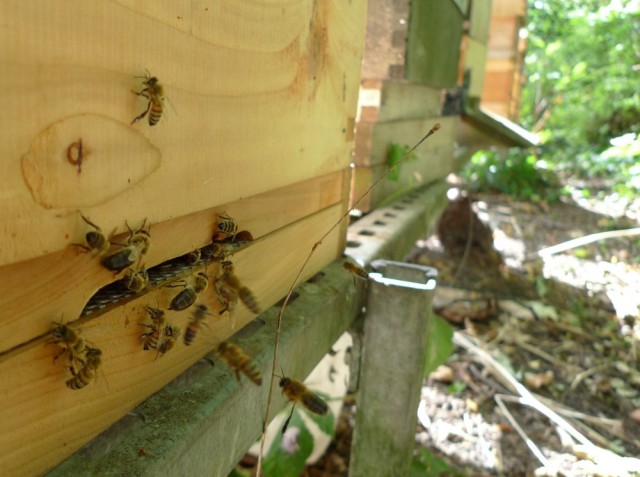
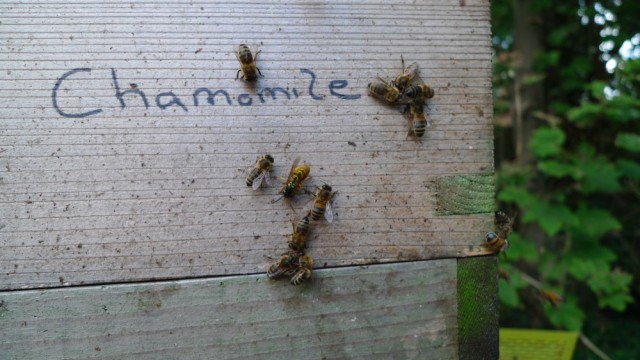
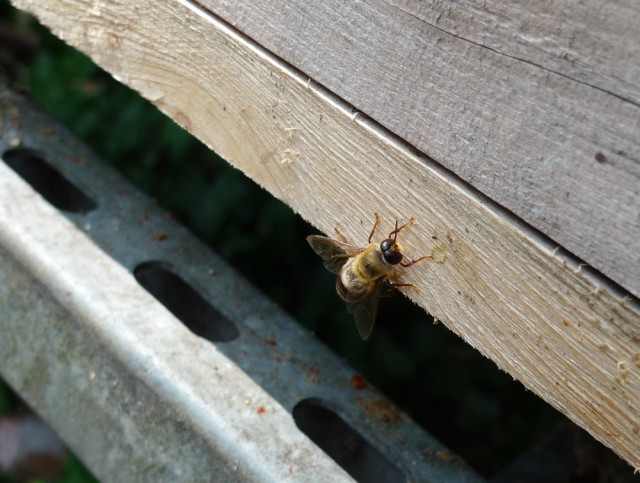
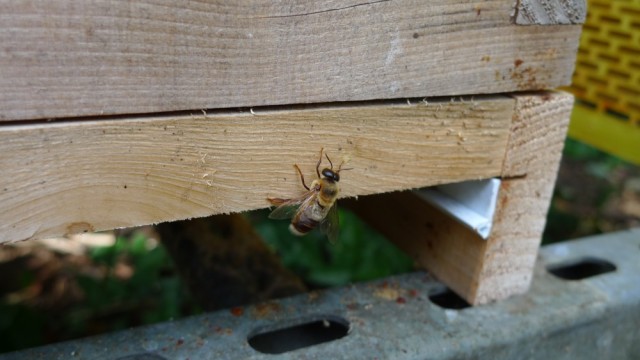

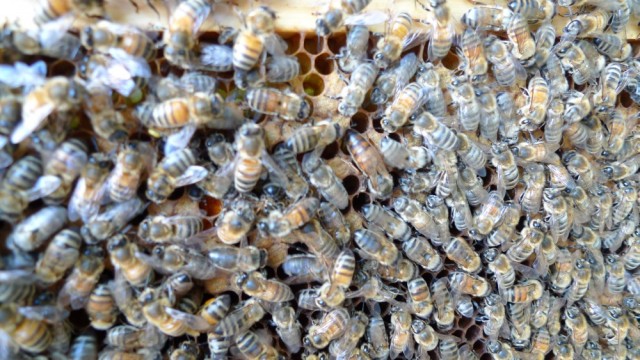
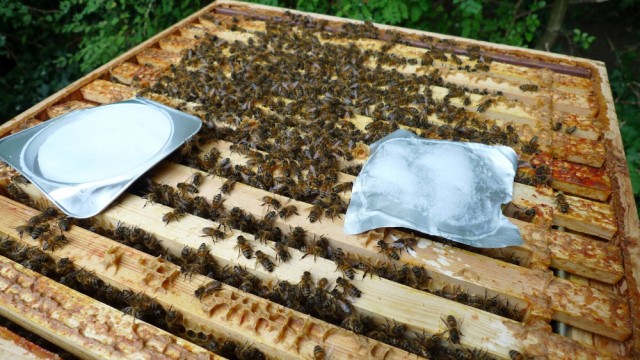
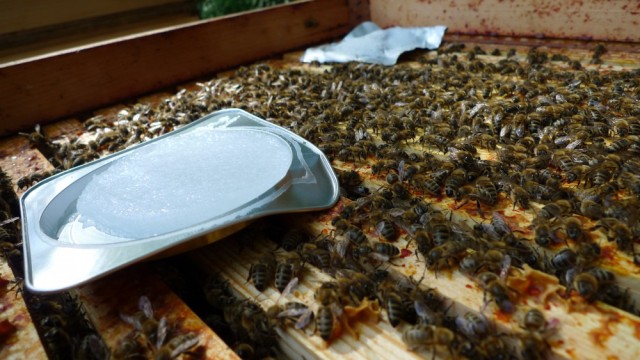
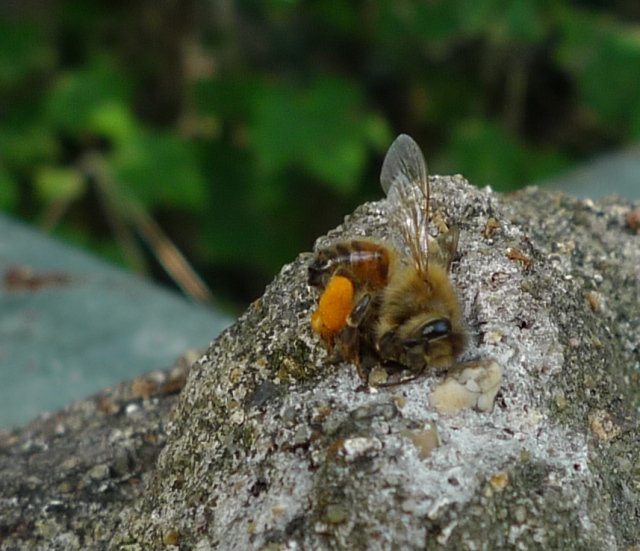
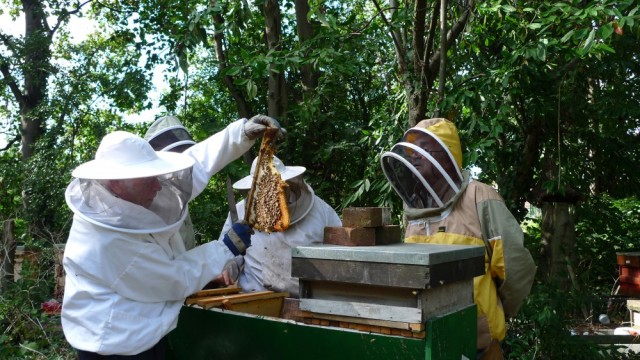

Emily, I found in this summer, which was hot, sunny and glorious (if too dry for a good honey flow…darnit) that I could inspect sans suit, gloves or veil if the day was nice and I kept my movements quiet. However, beekeeping mentors did advise that I keep the veil handy (spend enough time poking around a hive and eventually a guard is going to take a run at you), and to keep a lit smoker handy. The smoker was useful for clearing bridge comb so I could scrape it off the top bars, and I was told that if things got suddenly, unpredictably nasty, the smoker would come in handy. And I always had an escape plan, in case I knocked over a hive by accident and had to scramble for safety. In any case, I also mastered the art of keeping a good smudge going…I make packets out of white wood chips like you bed small animals (hamsters, guinea pigs) on, with some of my own dried Catmint leaves shredded in (smells nice), and burlap. I cut a piece of natural fibre burlap about 10″ square, place a handful of the wood chip mix inside, roll up securely, tuck over the ends and tie it all up quickly with garden twine. Stuff one inside your smoker, light with your butane torch, get it fiery, stuff in another, close up, puff away and all set for an hour or so!
LikeLike
No veil – you really are brave! I like the sound of your packets, I used to use wood chips from the pet shop and remember that working well. This is probably a silly question but where do you get burlap from? There’s no gardening shops near me and I can’t think which other shops would sell it. Perhaps I can buy it online…
LikeLike
It sounds like things are cooler for you than here. In spite of a cool summer, we are still around 80 degrees here. No winterizing here till October. Hoping to get some frames of honey from a fall harvest. John has really cut back on using the smoker. He used it at harvest, but mostly does without.
LikeLike
We did reach 80 degrees, and even 85 degrees, here for a couple of weeks – it’s been an unusually hot summer. But for the last couple of weeks we’ve had crazy rain and cooler temps. Can’t complain really, it’s been the best year for honey I’ve ever had. Good luck with your fall harvest.
LikeLike
And ours has been unusually cool. We had temps go down into the 50s at night multiple times in August. Last time it hit 90 during the day was in July. Happy for your good harvest!
LikeLike
So interesting that you managed to open the hive without a smoker. I once saw a video of someone using sugar solution to calm the bees but I’m sure there must be a down side to this as everybody would use it. Do you know anything about it? Poor lost bee, I often see bees that look completely over-loaded. Bumble bees are the worse culprits and often fall off the leaves and flowers as their pollen sacs are so heavy. Amelia
LikeLike
I like the sugar idea too but feel I don’t really need to calm the bees. Mostly we use the smoker to get the bees to go down when putting the hive boxes back together, so they don’t get squashed – the sugar solution probably wouldn’t help with that.
It must be tempting for the bees to pack as much into those baskets as possible per flight, but obviously there’s a limit to how much they can carry!
LikeLike
I had not quite realised that the smoke was mainly to make the bees go into the hive. Thanks.
LikeLike
That’s only in our case, as our bees are nice. Sometimes we do need to smoke them to calm them down if they get a bit ‘buzzy’, but most of the time they’re gentle creatures.
LikeLike
Its interesting what you say about the smoker – I too find it frustrating, and am concerned about the impact on the bees as well as the honey. It would be great to do without. That said we are off to harvest Jean-Philippe’s hives this afternoon, and will be going fully armed.
LikeLike
Hope you get a good harvest 🙂
LikeLike
I enjoyed this blog 🙂
LikeLike
Reblogged this on Linda's wildlife garden and commented:
awesome and thank you for sharing have a blessed week
LikeLike
Thanks Linda, you too.
LikeLiked by 1 person
We use water spray primarily. And haven’t used much smoke at all. Sometimes it feels like the bees are agitated by it. I also felt for that bee you found in the roof. So much hard work : (
LikeLike
I feel it upsets them too. Plus I get annoyed trying to keep the damn thing alight! Interesting to hear that you use water spray.
LikeLike
The spray is really good. They think it’s rain. They are calmed and retreat.
LikeLike
Is it really the end of the season? It seems to have come too soon. Anyway I hope you achieve your aim of no colony losses this winter.
LikeLike
Thanks Philip. With the cruelly cold soggy rain today it feels like autumn is here all of a sudden.
LikeLike
I agree with Philip. The season did seem to end too soon. I was sad to see that bee on its side, pollen baskets full. Many don’t think how hard bees work and sometimes if it fruitless like this poor girl. Same for the young drone. No chance to pass on his genes to the next generation. Funny how life is sometimes. I think your bees are very appreciative of you and what you do for them. I always think that when I am in my garden and the native bees buzz around me. But unlike you tending your bees, I try not to get in their way for my own benefit.
LikeLike
They do work incredibly hard and deserve more appreciation from us humans. All the effort you put into making your garden pollinator friendly is fantastic.
LikeLike
Great re-cap on your recent trip(s). I hope you manage to pull all your girls through the dark days, I usually seem to loose about 50%, but this year I’m going to do what I have done with the hives that have made it through the winter for the past few years. We don’t have too much cold, just wet. Let me know when you get the place with the big yard and pizza oven, my family will come and camp out!
LikeLike
Thank you, you will be most welcome to come over when I get my huge grounds and pizza oven, complete with personal chef to complete the pizza! Sorry to hear you lose about 50%, if you have a wet climate that must be very tricky to contend with, wet is worse than cold for bees.
LikeLike
That’s the perennial problem with the Puget Sound. Screened bottoms and a empty top super full of wood chips is the plan for this year.
LikeLike
I saw myself visiting my girls while reading this post! When I started my beekeeping adventure I used Apiguard too, but 2 or 3 years ago I switched it with Api life var. Quite good as anti varroa treatment but only after oxalic acid.
I totally agree with u about the frustrating effort of keeping the smoker lit, and since I don’t like using paper or pieces of carton boxes (which may have glue inside, not good for bees, either for us!) I tried with dry butcher’s broom, dry leaves and little dead branches. It works. Once I tried Apicalm (a natural bee granulated smoker fuel) and I recommend it, especially to whom doesn’t have time to look for dry stuff in his garden or is not so brave to make an inspection without smoke (a little parenthesis: years ago I visited a family and removed queen cells with no smoke and no gloves. So what? I got stung by 2 bees and went to the er where it turned out I am allergic to bee venom…). I also saw old skilful beekeepers using no smoke, wearing no masks or gloves and any protective beekeeping clothing, just jeans, t-shirt and a pipe!!!chapeau!
Two weeks ago I started preparing hives getting ready for winter, so we are at the same point! we’ll see if our work will be rewarded with no losses 🙂
LikeLiked by 1 person
Thanks Iole, I haven’t tried Apicalm, that is worth investigating. You are brave to keep bees when you’re allergic. Amazing about those old beekeepers not using protection! Best of luck getting your bees through winter too.
LikeLike